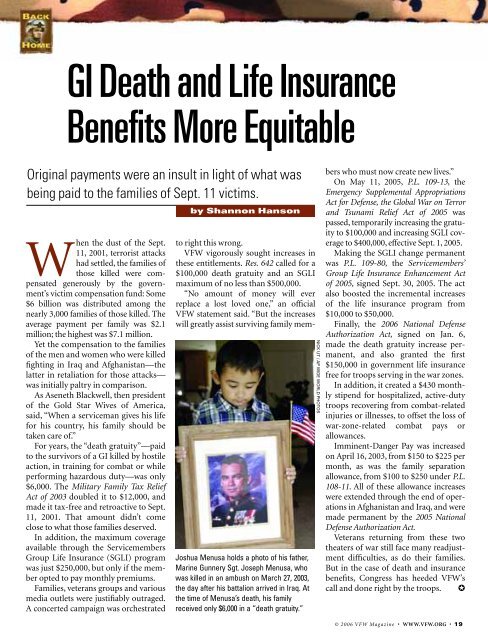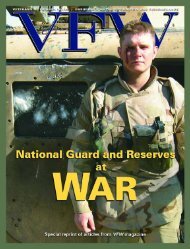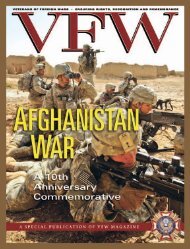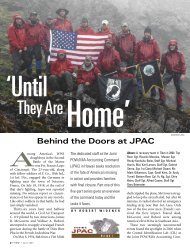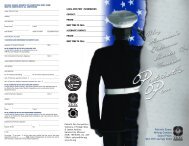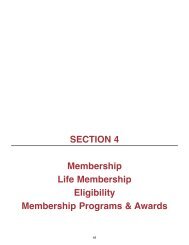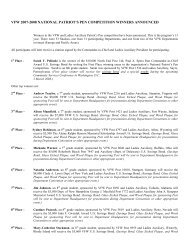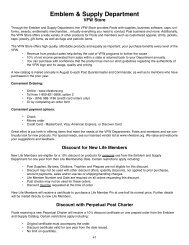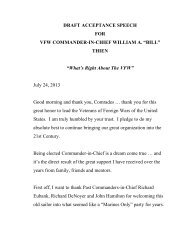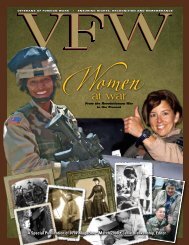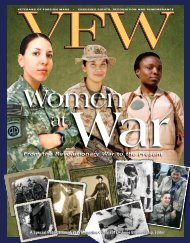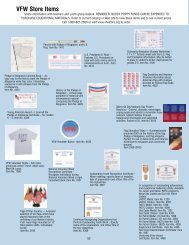2006 VFW Magazine - Veterans of Foreign Wars
2006 VFW Magazine - Veterans of Foreign Wars
2006 VFW Magazine - Veterans of Foreign Wars
You also want an ePaper? Increase the reach of your titles
YUMPU automatically turns print PDFs into web optimized ePapers that Google loves.
GI Death and Life Insurance<br />
Benefits More Equitable<br />
Original payments were an insult in light <strong>of</strong> what was<br />
being paid to the families <strong>of</strong> Sept. 11 victims.<br />
When the dust <strong>of</strong> the Sept.<br />
11, 2001, terrorist attacks<br />
had settled, the families <strong>of</strong><br />
those killed were compensated<br />
generously by the government’s<br />
victim compensation fund: Some<br />
$6 billion was distributed among the<br />
nearly 3,000 families <strong>of</strong> those killed. The<br />
average payment per family was $2.1<br />
million; the highest was $7.1 million.<br />
Yet the compensation to the families<br />
<strong>of</strong> the men and women who were killed<br />
fighting in Iraq and Afghanistan—the<br />
latter in retaliation for those attacks—<br />
was initially paltry in comparison.<br />
As Aseneth Blackwell, then president<br />
<strong>of</strong> the Gold Star Wives <strong>of</strong> America,<br />
said, “When a serviceman gives his life<br />
for his country, his family should be<br />
taken care <strong>of</strong>.”<br />
For years, the “death gratuity”—paid<br />
to the survivors <strong>of</strong> a GI killed by hostile<br />
action, in training for combat or while<br />
performing hazardous duty—was only<br />
$6,000. The Military Family Tax Relief<br />
Act <strong>of</strong> 2003 doubled it to $12,000, and<br />
made it tax-free and retroactive to Sept.<br />
11, 2001. That amount didn’t come<br />
close to what those families deserved.<br />
In addition, the maximum coverage<br />
available through the Servicemembers<br />
Group Life Insurance (SGLI) program<br />
was just $250,000, but only if the member<br />
opted to pay monthly premiums.<br />
Families, veterans groups and various<br />
media outlets were justifiably outraged.<br />
A concerted campaign was orchestrated<br />
by Shannon Hanson<br />
Joshua Menusa holds a photo <strong>of</strong> his father,<br />
Marine Gunnery Sgt. Joseph Menusa, who<br />
was killed in an ambush on March 27, 2003,<br />
the day after his battalion arrived in Iraq. At<br />
the time <strong>of</strong> Menusa’s death, his family<br />
received only $6,000 in a “death gratuity.”<br />
NICK UT / AP WIDE WORLD PHOTOS<br />
to right this wrong.<br />
<strong>VFW</strong> vigorously sought increases in<br />
these entitlements. Res. 642 called for a<br />
$100,000 death gratuity and an SGLI<br />
maximum <strong>of</strong> no less than $500,000.<br />
“No amount <strong>of</strong> money will ever<br />
replace a lost loved one,” an <strong>of</strong>ficial<br />
<strong>VFW</strong> statement said. “But the increases<br />
will greatly assist surviving family members<br />
who must now create new lives.”<br />
On May 11, 2005, P.L. 109-13, the<br />
Emergency Supplemental Appropriations<br />
Act for Defense, the Global War on Terror<br />
and Tsunami Relief Act <strong>of</strong> 2005 was<br />
passed, temporarily increasing the gratuity<br />
to $100,000 and increasing SGLI coverage<br />
to $400,000, effective Sept. 1, 2005.<br />
Making the SGLI change permanent<br />
was P.L. 109-80, the Servicemembers’<br />
Group Life Insurance Enhancement Act<br />
<strong>of</strong> 2005, signed Sept. 30, 2005. The act<br />
also boosted the incremental increases<br />
<strong>of</strong> the life insurance program from<br />
$10,000 to $50,000.<br />
Finally, the <strong>2006</strong> National Defense<br />
Authorization Act, signed on Jan. 6,<br />
made the death gratuity increase permanent,<br />
and also granted the first<br />
$150,000 in government life insurance<br />
free for troops serving in the war zones.<br />
In addition, it created a $430 monthly<br />
stipend for hospitalized, active-duty<br />
troops recovering from combat-related<br />
injuries or illnesses, to <strong>of</strong>fset the loss <strong>of</strong><br />
war-zone-related combat pays or<br />
allowances.<br />
Imminent-Danger Pay was increased<br />
on April 16, 2003, from $150 to $225 per<br />
month, as was the family separation<br />
allowance, from $100 to $250 under P.L.<br />
108-11. All <strong>of</strong> these allowance increases<br />
were extended through the end <strong>of</strong> operations<br />
in Afghanistan and Iraq, and were<br />
made permanent by the 2005 National<br />
Defense Authorization Act.<br />
<strong>Veterans</strong> returning from these two<br />
theaters <strong>of</strong> war still face many readjustment<br />
difficulties, as do their families.<br />
But in the case <strong>of</strong> death and insurance<br />
benefits, Congress has heeded <strong>VFW</strong>’s<br />
call and done right by the troops. ✪<br />
© <strong>2006</strong> <strong>VFW</strong> <strong>Magazine</strong> • WWW.<strong>VFW</strong>.ORG • 19


